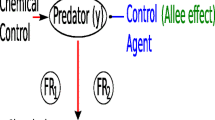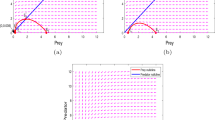Abstract
Intraspecific interactions such as Allee effects are key properties that can guide population management. This contribution considers component Allee effects that are elementary mechanisms leading to declines of fitness at the population scale, i.e. demographic Allee effects. It especially focuses on the consequences of such properties in predator populations, and investigates their repercussions in a biological control context. A modelling framework able to account for reproductive and/or foraging component Allee effects is proposed. From this, four models of augmentative biological control, corresponding to the periodic introduction of natural enemies, have been investigated. This is done using semi-discrete models: ordinary differential equations are used to depict predator–prey dynamics and a discrete equation describes the abrupt augmentation of predators at periodic intervals. In that context, stability of a prey-free solution corresponding to pest eradication has been analyzed. It has been found that rare but large introductions should be preferred over frequent and small ones, when Allee effects influence predator populations. In particular, the occurrence of foraging, rather than reproducing, Allee effects significantly hinders pest eradication. Cases where the pest-free solution is locally, but not globally, stable were also observed and were shown to be favored by the occurrence of reproductive Allee effects among predators.



Similar content being viewed by others
Notes
The following notation has been used to split an integral into three integrals:
$$\begin{aligned} \int _{t_0}^{t}{F(\tau )d\tau } = \int _{t_0}^{t_1}{F(\tau )d\tau } + \int _{t_1}^{t_2}{F(\tau )d\tau } + \int _{t_2}^{t}{F(\tau )d\tau } = \left( \int _{t_0}^{t_1} + \int _{t_1}^{t_2} + \int _{t_2}^{t} \right) F(\tau )d\tau \end{aligned}$$
References
Allee WC (1949) Principles of animal ecology. W. B, Saunders Company, Philadelphia, London
Bale J, Van Lenteren J, Bigler F (2008) Biological control and sustainable food production. Philos Trans R Soc Lond B Biol Sci 363(1492):761–776
Bazykin AD (1998) Nonlinear dynamics of interacting populations, vol 11. World Scientific, Singapore
Berec L, Angulo E, Courchamp F (2007) Multiple Allee effects and population management. Trends Ecol Evol 22(4):185–191
Bolognesi C, Morasso G (2000) Genotoxicity of pesticides: potential risk for consumers. Trends Food Sci Technol 11(4):182–187
Bompard A, Amat I, Fauvergue X, Spataro T (2013) Host-parasitoid dynamics and the success of biological control when parasitoids are prone to allee effects. PLoS One 8(e76):768. doi:10.1371/journal.pone.0076768
Boukal DS, Berec L (2009) Modelling mate-finding allee effects and populations dynamics, with applications in pest control. Popul Ecol 51(3):445–458
Collier T, Steenwyk R (2004) A critical evaluation of augmentative biological control. Biol Control 31(2):245–256
Courchamp F, Macdonald DW (2001) Crucial importance of pack size in the african wild dog Lycaon pictus. Anim Conserv 4(02):169–174
Courchamp F, Berec L, Gascoigne J (2008) Allee effects in ecology and conservation. Oxford University Press, Oxford
DeBach P, Rosen D (1991) Biological control by natural enemies. CUP Archive, Cambridge University Press, New York
Derederec A, Courchamp F (2007) Importance of the allee effect for reintroductions. Écoscience 14:440–451
Drury KL, Lodge DM (2009) Using mean first passage times to quantify equilibrium resilience in perturbed intraguild predation systems. Theor Ecol 2(1):41–51
Dyck VA, Hendrichs J, Robinson AS (2005) Sterile insect technique. Springer, Dordrecht
Elliott N, Farrell J, Gutierrez A, van Lenteren JC, Walton M, Wratten S, Dent D (1995) Integrated pest management. Chapman Hall, London
Fauvergue X, Hopper KR (2009) French wasps in the new world: experimental biological control introductions reveal a demographic allee effect. Popul Ecol 51:385–397
Floquet G (1883) Sur les équations différentielles linéaires à coefficients périodiques. In: Gauthier-Villars (ed) Annales scientifiques de l’École normale supérieure, vol 12, pp 47–88
Gascoigne J, Berec L, Gregory S, Courchamp F (2009) Dangerously few liaisons: a review of mate-finding allee effects. Popul Ecol 51(3):355–372
Ghosh B, Grognard F, Mailleret L (2015) Natural enemies deployment in patchy environments for augmentative biological control. Appl Math Comput 266:982–999
Holling CS (1959) The components of predation as revealed by a study of small-mammal predation of the european pine sawfly. Can Entomol 91:293–320
Jiang G, Lu Q (2007) Impulsive state feedback control of a predator-prey model. J Comput Appl Math 200(1):193–207
Khalil HK, Grizzle J (2002) Nonlinear systems, vol 3. Prentice Hall, Upper Saddle River
Lacey L, Frutos R, Kaya H, Vail P (2001) Insect pathogens as biological control agents: do they have a future? Biol Control 21(3):230–248
Lakshmikantham V, Bainov D, Simeonov PS (1989) Theory of impulsive differential equations. World Scientific, Singapore
Liebhold AM, Tobin PC (2008) Population ecology of insect invasions and their management. Annu Rev Entomol 53:387–408
Lu ZH, Chi XB, Chen LS (2003) Impulsive control strategies in biological control of pesticide. Theor Popul Biol 64(1):39–47
Mailleret L, Grognard F (2006) Optimal release policy for prophylactic biological control. Posit Syst 341:89–96
Mailleret L, Grognard F (2009) Global stability and optimisation of a general impulsive biological control model. Math Biosci 221:91–100
Mailleret L, Lemesle V (2009) A note on semi-discrete modelling in the life sciences. Philos Trans R Soc A Math Phys Eng Sci 367:2113–2138
MATLAB (2012) Version 8.0.0 (R2012b). The MathWorks Inc., Natick, Massachusetts, United States
McLaughlin A, Mineau P (1995) The impact of agricultural practices on biodiversity. Agric Ecosyst Environ 55(3):201–212
Møller AP, Gregersen J (1994) Sexual selection and the barn swallow, vol 8. Oxford University Press, Oxford
Møller AP, Legendre S (2001) Allee effect, sexual selection and demographic stochasticity. Oikos 92(1):27–34
Nie L, Teng Z, Hu L, Peng J (2009) Existence and stability of periodic solution of a predator-prey model with state-dependent impulsive effects. Math Comput Simul 79(7):2122–2134
Nundloll S, Mailleret L, Grognard F (2010a) Influence of intrapredatory interferences on impulsive biological control efficiency. Bull Math Biol 72(8):2113–2138
Nundloll S, Mailleret L, Grognard F (2010b) Two models of interfering predators in impulsive biological control. J Biol Dyn 4(1):102–114
Oerke EC (2006) Crop losses to pests. J Agric Sci 144(01):31–43
Pimentel D, Edwards CA (1982) Pesticides and ecosystems. BioScience 32(7):595–600
Pimentel D, Acquay H, Biltonen M, Rice P, Silva M, Nelson J, Lipner V, Giordano S, Horowitz A, D’amore M (1992) Environmental and economic costs of pesticide use. BioScience 42(10):750–760
Rosenzweig ML, MacArthur RH (1963) Graphical representation and stability conditions of predator-prey interactions. Am Nat 97(895):209–223
Simberloff D (2009) The role of propagule pressure in biological invasions. Annu Rev Ecol Evol Syst 40:81–102
Stephens PA, Sutherland WJ (1999) Consequences of the allee effect for behaviour, ecology and conservation. Trends Ecol Evol 14(10):401–405
Tang S, Cheke RA (2005) State-dependent impulsive models of integrated pest management (ipm) strategies and their dynamic consequences. J Math Biol 50(3):257–292
Tang S, Xiao Y, Cheke RA (2008) Multiple attractors of host-parasitoid models with integrated pest management strategies: eradication, persistence and outbreak. Theor Popul Biol 73(2):181–197
Tang S, Tang G, Cheke RA (2010) Optimum timing for integrated pest management: modelling rates of pesticide application and natural enemy releases. J Theor Biol 264(2):623–638
Tang S, Liang J, Tan Y, Cheke RA (2013) Threshold conditions for integrated pest management models with pesticides that have residual effects. J Math Biol 66(1–2):1–35
Terry AJ (2014a) Biocontrol in an impulsive predator-prey model. Math Biosci 256:102–115
Terry AJ (2014b) A predator-prey model with generic birth and death rates for the predator. Math Biosci 248:57–66
Terry AJ (2015) Predator-prey models with component allee effect for predator reproduction. J Math Biol 71(6–7):1325–1352
Van Lenteren J (1995) Integrated pest management in protected crops. In: Dent D (ed) Integrated pest management. Chapman & Hall, London, pp 311–343
Van Lenteren J (2000) Success in biological control of arthropods by augmentation of natural enemies. In: Wratten S, Gurr G (eds) Biological control: measures of success. Springer, Berlin, pp 77–103
Van Lenteren JC, Bueno VH (2003) Augmentative biological control of arthropods in Latin America. BioControl 48(2):123–139
Verdy A (2010) Modulation of predator-prey interactions by the Allee effect. Ecol Model 221:1098–1107
Wang S, Huang Q (2015) Bifurcation of nontrivial periodic solutions for a Beddington-Beangelis interference model with impulsive biological control. Appl Math Model 39(5):1470–1479
Wilson C, Tisdell C (2001) Why farmers continue to use pesticides despite environmental, health and sustainability costs. Ecol Econ 39(3):449–462
Wittmann MJ, Metzler D, Gabriel W, Jeschke JM (2014) Decomposing propagule pressure: the effects of propagule size and propagule frequency on invasion success. Oikos 123(4):441–450
Zhang H, Georgescu P, Chen L (2008) On the impulsive controllability and bifurcation of a predator-pest model of ipm. BioSystems 93(3):151–171
Zhou SR, Liu YF, Wang G (2005) The stability of predator-prey systems subject to the Allee effects. Theor Popul Biol 67:23–31
Acknowledgments
The research leading to these results has received funding from the European Union Seventh Framework Programme (FP7/2007-2013) under the Grant n265865 (PURE project). This work also benefited from the support of UMT Fiorimed, certified by the French Ministry of Higher Education and Research (2015–2019). This work is part of the PhD thesis of Nicolas Bajeux which is funded by University of Nice Sophia Antipolis. We gratefully thank both reviewers as well as the editors for their relevant and meaningful comments.
Author information
Authors and Affiliations
Corresponding author
Rights and permissions
About this article
Cite this article
Bajeux, N., Grognard, F. & Mailleret, L. Augmentative biocontrol when natural enemies are subject to Allee effects. J. Math. Biol. 74, 1561–1587 (2017). https://doi.org/10.1007/s00285-016-1063-8
Received:
Revised:
Published:
Issue Date:
DOI: https://doi.org/10.1007/s00285-016-1063-8
Keywords
- Predator–prey models
- Positive density dependence
- Impulsive differential equations
- Semi-discrete models
- Stabilization




